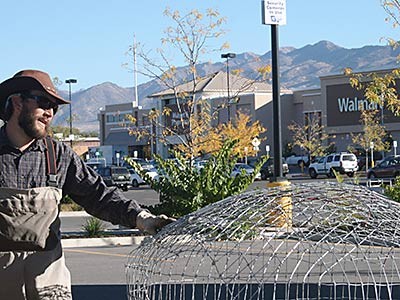USU Scientists Lead Innovative Wetlands Effort with Beavers, Walmart
Aggie researcher Scott Shahverdian unloads a USU-built pond leveler at Logan, Utah's south Walmart store for a water conservation project. The leveler is designed to prevent beaver dams in the surrounding creek from causing flooding.
Preoccupied with the day’s errands as you pull into the parking lot at Logan, Utah’s, south Walmart Supercenter, you might not even notice it. But the multi-shop retail store is partially ringed by Spring Creek, a tributary of the Logan River. And in those waters, shrouded by willows, cattails and other vegetation live long-time Cache Valley inhabitants: beavers.
In negotiations with Logan City, Walmart agreed to maintain the wetlands on its property, when the global retailer added a second location to the northern Utah town in 2006. What the retailer didn’t bargain for was its big-toothed neighbors’ relentless dam-building efforts that threaten flooding the store’s campus and surrounding roads and properties.
What to do?
“Beavers play a critical role in maintaining healthy aquatic and riparian habitat, which we desperately need in arid Utah, but they don’t stop,” says Utah State University researcher Elijah Portugal. “They can be a nuisance and their constant dam-building can cause damaging flooding.”
After repeated, unsuccessful attempts to move the beavers and the animals’ dams from its property, Walmart, prompted by the Bear River Watershed Council, turned to USU’s Fluvial Habitats Lab and local consulting group Eco Logical Research, Inc. for assistance.
“Beavers provide multiple benefits that are difficult and expensive for humans to accomplish,” says Nick Bouwes, adjunct faculty member in USU’s Department of Watershed Sciences and owner of Eco Logical Research. “We believe there are ways to co-exist with beavers, while mitigating their harmful habits.”
To this end, Bouwes, Portugal, their students, Utah Conservation Corps members and community volunteers gathered at the Logan Walmart Oct. 12 to install two pond levelers, crafted in the USU lab, to the store’s surrounding waters.
The cage-like levelers, made from wire, are connected to large plastic tubes that allow water to pass, while catching debris, and prevent beavers from building dams to flood-inducing heights. The researchers installed a leveler on each of two beaver dams on the south side of Walmart’s property.
“The levelers will maintain the height of the ponds at a safe, desired level, without disturbing the beavers and their efforts,” Bouwes says. “It’s a winning solution for Walmart, the beavers and the surrounding community.”
Prized for their pelts, North American beavers were nearly hunted to extinction by the late 19th century. Cache Valley, after all, gained its name from trappers who cached their pelts and supplies in the area for safekeeping.
Today’s fashion-savvy men no longer favor top hats made from beaver fur, but the furry critters still hold great value for humans.
“Since the arrival of European settlers, many streams throughout the West and the habitats they provide have been degraded,” says Joe Wheaton, USU Watershed Sciences faculty member and head of the USU Fluvial Habitats Lab. “Beavers are emerging as a valuable resource in river restoration. These stubborn, little mammals do a much better engineering job than humans and provide a less obtrusive and less expensive alternative to river restoration.”
Portugal says beavers play a key role in maintaining healthy aquatic ecosystems in Cache Valley.
“Beaver dams store water in springtime, slow down the release of snowpack and prevent water from moving too quickly and evaporating, which benefits all downstream users,” he says. “The dams also capture sediment, which improves water quality. All of these activities are important, especially in light of climate change, in protecting our precious water resources.”
Walmart welcomes USU’s expertise.
“We appreciate the work of the Utah State University Quinney College of Natural Resources and the Utah Conservation Corps in addressing recurring concerns regarding beaver activity in the creek beside the south Logan Walmart, “ wrote Delia Garcia, Walmart director of communications in a Oct. 12 statement. “Their expertise in the area of riparian habitat preservation and humane beaver deterrence has led to the implementation of a long-term strategy that addresses the potentially destructive impacts of unmanaged beaver dams while preserving the riparian habitat and cultivating a rich environment for the creek's natural inhabitants.”
Related links:
- “Project Helps Protect Logan Beavers, Reduces Threat of Flooding,” KSL-TV News
- VIDEO: “Partnering with Beaver: Nature’s Hydrologists and Ecosystem Engineers”
- USU Department of Watershed Sciences
- The Fluvial Habitats Center
- USU Quinney College of Natural Resources
Contact: Joe Wheaton, 435-554-1247, joe.wheaton@usu.edu
Contact: Nick Bouwes, 435-760-771, nbouwes@gmail.com
Writer: Mary-Ann Muffoletto, 435-797-3517, maryann.muffoletto@usu.edu
In creek waters surrounding Logan, Utah's south Walmart, USU researchers Elijah Portugal, Nick Bouwes and Scott Shahverdian ease a pond leveler and tube into place on a beaver dam. The leveler will prevent flooding without disturbing the beavers.
TOPICS
Ecosystems 130stories Rivers 101stories Solutions 64storiesComments and questions regarding this article may be directed to the contact person listed on this page.








